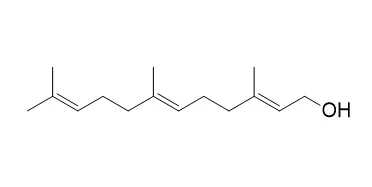| In vitro: |
| Journal of Biological Chemistry, 2000, 275(15):11484-11491. | | Farnesol Stimulates Differentiation in Epidermal Keratinocytes via PPARα.[Reference: WebLink] | The isoprenoids Farnesol and juvenile hormone III (JH), metabolites of the cholesterol biosynthetic pathway, have been shown to stimulate fetal epidermal development in rodents.
METHODS AND RESULTS:
In this study we determined whether this effect might be attributed to a direct induction of keratinocytes differentiation and examined the mechanisms responsible for these effects. Rates of cornified envelope formation, a marker of keratinocyte terminal differentiation, as well as protein and mRNA levels of two proteins required for cornified envelope formation, involucrin (INV) and transglutaminase, increased 2- to 3-fold in normal human keratinocytes (NHK) treated with either Farnesol or JH, even at low calcium concentrations (0.03 mm), which otherwise inhibit differentiation. In contrast, neither cholesterol nor mevalonate affected INV or transglutaminase mRNA levels. Effects of Farnesol and JH on INV and transglutaminase mRNA levels were additive with high calcium concentrations (1.2 mm) that independently stimulate keratinocyte differentiation. In contrast, keratinocyte DNA synthesis was inhibited by these compounds. Both Farnesol and JH stimulated INV and transglutaminase promoter activity, suggesting regulation at the transcriptional level. A series of truncation and deletion experiments revealed a Farnesol-responsive region (−2452 to −1880 base pairs (bp)) in the INV gene. This region contained an AP-1 site. A single base pair mutation of the AP-1 site at −2116 to −2110 bp abolished Farnesol responsiveness, identical to effects by peroxisome proliferator-activated receptor (PPARα) activators. Farnesoid X-activated receptor mRNA was not detected in NHK, but Farnesol treatment increased activities of both a PPAR response element and PPARα mRNA levels in NHK. Furthermore, the increase in PPRE activity by Farnesol was dependent upon PPARα in CV-1 cells. Finally, topical applications of Farnesol increased mRNA and protein levels of the differentiation-specific genes, profilaggrin and loricrin, determined by immunohistochemistry and in situhybridization, in wild-type but not in PPARα−/− murine epidermis.
CONCLUSIONS:
These findings suggest a novel role for selected isoprenoid cholesterol intermediates in the regulation of differentiation-specific gene transcription and a convergence of PPARα with the cholesterol synthetic pathway. | | Molecular Microbiology, 2008,67(1):47-62. | | Farnesol and dodecanol effects on the Candida albicans Ras1‐cAMP signalling pathway and the regulation of morphogenesis.[Reference: WebLink] |
METHODS AND RESULTS:
Candida albicans hypha formation which has been stimulated via the Ras1‐cAMP‐Efg1 signalling cascade is inhibited by Farnesol, a C. albicans autoregulatory factor, and small molecules such as dodecanol. In cultures containing Farnesol or dodecanol, hypha formation was restored upon addition of dibutyryl‐cAMP. The CAI4‐Ras1G13V strain, which carries a dominant‐active variant of Ras1 and forms hyphae in the absence of inducing stimuli, grew as yeast in medium with Farnesol or dodecanol; the heat shock sensitivity of the CAI4‐Ras1G13V strain was also suppressed by these compounds. Neither Pde1 nor Pde2 was necessary for the repression of hyphal growth by Farnesol or dodecanol. Two transcripts, CTA1 and HSP12 , which are at higher levels upon mutation of Ras1 or Cdc35, were increased in abundance in cells grown with Farnesol or dodecanol. Microscopic analysis of strains carrying CTA1 and HWP1 promoter fusions grown with intermediate concentrations of Farnesol or dodecanol indicated a link between cells with the increased expression of cAMP‐repressed genes and cells repressed for hypha formation.
CONCLUSIONS:
Because several cAMP‐controlled outputs are affected by Farnesol and dodecanol, our findings suggest that these compounds impact activity of the Ras1‐Cdc35 pathway, thus leading to an alteration of C. albicans morphology.
| | Cytokine, 2009, 45(2):132-140. | | Farnesol promotes epithelial cell defense against Candida albicans through Toll-like receptor 2 expression, interleukin-6 and human β-defensin 2 production.[Pubmed: 19121950] | Farnesol, a quorum-sensing molecule, regulates virulence and morphogenesis in Candida albicans and is involved in various human pathologies including oral candidiasis. Oral epithelial cells are involved in innate immunity against Candida infections via Toll-like receptors (TLRs) and inflammatory mediators.
METHODS AND RESULTS:
We investigated the effects of Farnesol on host cells and its possible synergistic interaction with gingival epithelial cells against C. albicans infection by studying the expression of TLR2, 4 and 6. The production of IL-6, IL-8, and human β-defensins 1 and 2 was also examined using engineered human oral mucosa tissue put in contact with various concentrations of Farnesol with and without C. albicans. Our findings indicate that 24 h after contact with C. albicans, epithelial cells expressed more TLR2 than did non-infected cells. The addition of exogenous Farnesol upregulated the TLR2 expression by the gingival epithelial cells in the presence or absence of C. albicans. In contrast, TLR4 was down regulated when Farnesol was added to the tissue with or without C. albicans. Finally, Farnesol alone was shown to have no effect on TLR6, yet in the presence of both C. albicans and Farnesol, TLR6 expression was down regulated. Farnesol modulated TLR2 expression by the epithelial cells following tissue contact with C. albicans. This effect was paralleled by IL-6 but not IL-8 secretion. Farnesol’s effect on innate immunity was strengthened by its capacity to increase human β-defensin 2 production, and by the efficacy of β-defensin against C. albicans growth.
CONCLUSIONS:
Overall results showed that exogenous Farnesol promoted epithelial cell defense against C. albicans infection through the involvement of TLR2, IL-6, and human β-defensin 2. |
|






 Cell. 2018 Jan 11;172(1-2):249-261.e12. doi: 10.1016/j.cell.2017.12.019.IF=36.216(2019)
Cell. 2018 Jan 11;172(1-2):249-261.e12. doi: 10.1016/j.cell.2017.12.019.IF=36.216(2019) Cell Metab. 2020 Mar 3;31(3):534-548.e5. doi: 10.1016/j.cmet.2020.01.002.IF=22.415(2019)
Cell Metab. 2020 Mar 3;31(3):534-548.e5. doi: 10.1016/j.cmet.2020.01.002.IF=22.415(2019) Mol Cell. 2017 Nov 16;68(4):673-685.e6. doi: 10.1016/j.molcel.2017.10.022.IF=14.548(2019)
Mol Cell. 2017 Nov 16;68(4):673-685.e6. doi: 10.1016/j.molcel.2017.10.022.IF=14.548(2019)